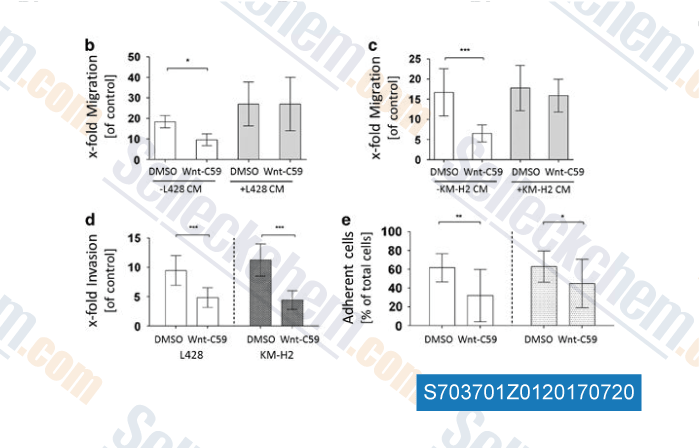|
Toll Free: (877) 796-6397 -- USA and Canada only -- |
Fax: +1-832-582-8590 Orders: +1-832-582-8158 |
Tech Support: +1-832-582-8158 Ext:3 Please provide your Order Number in the email. |
Technical Data
| Formula | C25H21N3O |
||||||
| Molecular Weight | 379.45 | CAS No. | 1243243-89-1 | ||||
| Solubility (25°C)* | In vitro | DMSO | 76 mg/mL (200.28 mM) | ||||
| Water | Insoluble | ||||||
| Ethanol | Insoluble | ||||||
| In vivo (Add solvents to the product individually and in order) |
|
||||||
|
* <1 mg/ml means slightly soluble or insoluble. * Please note that Selleck tests the solubility of all compounds in-house, and the actual solubility may differ slightly from published values. This is normal and is due to slight batch-to-batch variations. * Room temperature shipping (Stability testing shows this product can be shipped without any cooling measures.) |
|||||||
Preparing Stock Solutions
Biological Activity
| Description | Wnt-C59 (C59) is a PORCN inhibitor for Wnt3A-mediated activation of a multimerized TCF-binding site driving luciferase with IC50 of 74 pM in HEK293 cells. | ||
|---|---|---|---|
| Targets |
|
||
| In vitro | Wnt-C59 (C59) is claimed to inhibit PORCN enzyme activity at nanomolar concentrations. Wnt-C59 (10 nM) blocks the palmitoylation-dependent Wnt–WLS interaction in HeLa cells transfected with either WNT3A-V5 or WNT8A-V5 plasmids. Wnt-C59 (100 nM) prevents incorporation of palmitate into WNT3A in HeLa cells transfected with WNT3A-V5, consistent with inhibition of PORCN activity. Wnt-C59 (100 nM) inhibits the activity of all splice variants of murine PORCN in PORCN-null HT1080 cells transfected with PORCN. Wnt-C59 is a nanomolar inhibitor of mammalian PORCN acyltransferase activity and blocks activation of all evaluated human Wnts. Wnt-C59 does not significantly inhibit the proliferation of any of 46 tested cancer cell lines in vitro at concentrations that completely inhibit PORCN. [1] Wnt-C59 is capable to significantly inhibit proliferation and comparable to the ICG-001 treated NMuMG (NMG) cells. Wnt-C59 inhibits sphere formation by threefold in NMuMG (NMG) cells, which is dependent on Wnt10b-secretion. Wnt-C59 inhibits proliferation of human MDA-MB 231 cells by >50%. [2] Wnt-C59 (a Porcupine inhibitor) blocks radiolabel incorporation of [125I]iodo-pentadecanoate in mouse L-Wnt3a cells transfected with Flag-Porcupine. [3] | ||
| In vivo | Wnt-C59 concentration remains greater than 10-fold above the in vitro IC50 for at least 16 hours following a single oral dose (5 mg/kg) in mice. Wnt-C59 (10 mg/kg) prevents growth of MMTV-WNT1 tumors in female nude mice orthotopically transplanted with independent MMTV-WNT1 tumors. Wnt-C59 (10 mg/kg) decreases Wnt pathway activity and decreased proliferation in MMTV-WNT1 tumors in female nude mice orthotopically transplanted with independent MMTV-WNT1 tumors as evident by decreased expression of β-catenin target gene expression. [1] Wnt-C59 (10%) topically administered 4 weeks decreases the size of dysplasia of SmoM2-expressing cells in adult K14CREER/Rosa–SmoM2 mice. [4] |
Protocol (from reference)
| Cell Assay: |
|
|---|---|
| Animal Study: |
|
References
Customer Product Validation

-
, , Dev Neurobiol, 2016, 76(9):983-1002.

-
Data from [Data independently produced by , , Nat Commun, 2016, 7:12047]

-
Data from [Data independently produced by , , Oncogene, 2017, 36(1):13-23]

-
Data from [Data independently produced by , , J Endocrinol, 2018, 238(1):13-23]
Selleck's Wnt-C59 (C59) has been cited by 174 publications
| Binding of LncDACH1 to dystrophin impairs the membrane trafficking of Nav1.5 protein and increases ventricular arrhythmia susceptibility [ Elife, 2025, 12RP89690] | PubMed: 39773412 |
| Bioprinting-assisted Tissue Assembly for Structural and Functional Modulation of Engineered Heart Tissue Mimicking Left Ventricular Myocardial Fiber Orientation [ Adv Mater, 2024, e2400364.] | PubMed: 38717016 |
| Tumor Explants Elucidate a Cascade of Paracrine SHH, WNT, and VEGF Signals Driving Pancreatic Cancer Angiosuppression [ Cancer Discov, 2024, 14(2):348-361] | PubMed: 37966260 |
| PIBF1 regulates trophoblast syncytialization and promotes cardiovascular development [ Nat Commun, 2024, 15(1):1487] | PubMed: 38374152 |
| N-Acetyltransferase 10 represses Uqcr11 and Uqcrb independently of ac4C modification to promote heart regeneration [ Nat Commun, 2024, 15(1):2137] | PubMed: 38459019 |
| Hypoxia and TNF-alpha modulate extracellular vesicle release from human induced pluripotent stem cell-derived cardiomyocytes [ J Extracell Vesicles, 2024, 13(11):e70000] | PubMed: 39508403 |
| Ultrasound Mediated Polymerization for Cell Delivery, Drug Delivery, and 3D Printing [ Small Methods, 2024, e2301197.] | PubMed: 38376006 |
| Cardiac delivery of modified mRNA using lipid nanoparticles: Cellular targets and biodistribution after intramyocardial administration [ J Control Release, 2024, 369:734-745] | PubMed: 38604385 |
| The nutrient sensor CRTC and Sarcalumenin/thinman represent an alternate pathway in cardiac hypertrophy [ Cell Rep, 2024, 43(8):114549] | PubMed: 39093699 |
| ALK upregulates POSTN and WNT signaling to drive neuroblastoma [ Cell Rep, 2024, 43(3):113927] | PubMed: 38451815 |
RETURN POLICY
Selleck Chemical’s Unconditional Return Policy ensures a smooth online shopping experience for our customers. If you are in any way unsatisfied with your purchase, you may return any item(s) within 7 days of receiving it. In the event of product quality issues, either protocol related or product related problems, you may return any item(s) within 365 days from the original purchase date. Please follow the instructions below when returning products.
SHIPPING AND STORAGE
Selleck products are transported at room temperature. If you receive the product at room temperature, please rest assured, the Selleck Quality Inspection Department has conducted experiments to verify that the normal temperature placement of one month will not affect the biological activity of powder products. After collecting, please store the product according to the requirements described in the datasheet. Most Selleck products are stable under the recommended conditions.
NOT FOR HUMAN, VETERINARY DIAGNOSTIC OR THERAPEUTIC USE.
